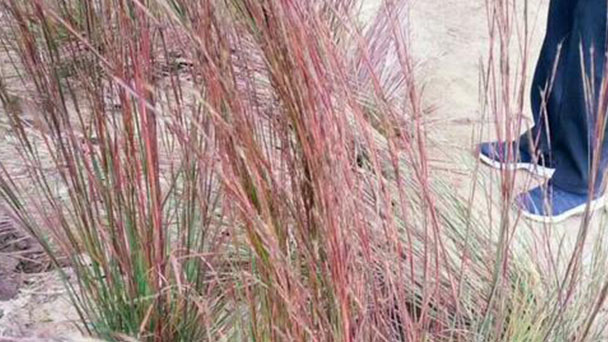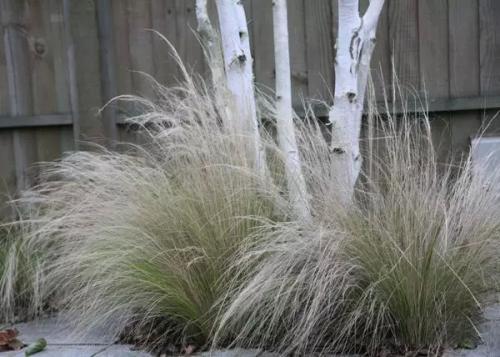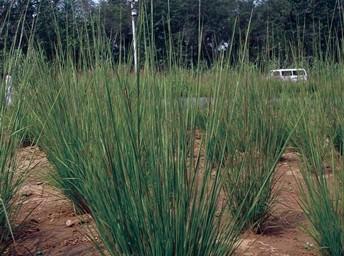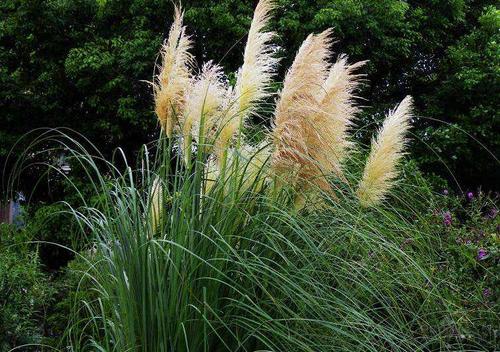Big bluestem (Andropogon gerardii) profile
Written by Maggie
Mar 29 2021

Big bluestem is a perennial tufts herb of Gramineae and Big Bluestem. Culms are erect, slender, subcylindrical, often purplish, glabrous, base densely bearing new tillers, with residual old withered leaf sheaths. Both sides of leaf sheaths compressed, the base longer than the lower part shorter than the internode, smooth glabrous; Ligule dry is membranous, apically truncate; Leaf blade is linear, often dyed with purple, base supported by linear lanceolate sheathlike spathe, the upper leaf blade degenerate, slightly longer than pedunculate; Raceme shaft is internode and tip of spikelet stalk slightly enlarged, dentate or cup-shaped appendage, margin densely covered with white tomentose, margin rough; Membranous is transparent, margin ciliate.
Big bluestem picutre

Big bluestem morphological characteristics
Big bluestem is a perennial caespitose herb; It is 20-70 cm high.Culms erect, slender, subcylindrical, often purplish, glabrous, base densely bearing new tillers, with residual old withered leaf sheaths. Both sides of leaf sheaths are compressed, the base longer than the lower part shorter than the internode, smooth glabrous; Ligule dry is membranous, 1-1.5 mm long, apex truncate; Leaf blade is linear, 10 -- 30 cm long, 2.5 -- 3.5 mm wide, flattened, stiffer, margin sparsely tuberculate basal hairs or glabrous. Racemes of Big bluestem are often more than 2, borne at the apex of main culms or branches, 1 -- 3 cm long, erect, often tinged with purple, base supported by linear lanceolate sheathlike spathe, upper leaves regressed, slightly longer than peduncle; Raceme axis is internode and tip of spikelet stalk slightly enlarged, dentate or cup-shaped appendages, margin densely white tomentose, 2 -- 4 mm long. Spikelets sessile ca. is 5 mm (with basal disc), basal disc obtuse, sparsely bearded; Dorsal part of first glume is furrowed or unfurled, 2-rigid, apically dentate or undentate; Second spikelets of Big bluestem are navicular, subequal to first glume, ridged, middle distal ridge scabrous;1st lemma slightly shorter than first glume, membranous transparent; Second lemma is linear, homogeneous to first lemma, apical 2-cleft palea 1/5-1/3 of the body, awns protruding from lobes; Awn knee is curved, awn column twisted, about 10 mm long; Lemma of Big bluestem is shorter; Big bluestem has 2 scales, ca. 0.5 mm; Big bluestem has 3 stamens, anthers purple, ca. 2.5 mm long, styles dissected, stigmas feathery. Spikelets stalk is lanceolate, first dorsal glume flat, with several veins, awnless, margin rough; Second glume is slightly shorter than first glume, with 3 veins;1st lemma ca. 2/3 of first glume, membranous transparent, margin ciliate; 2nd lemma is lanceolate or linear or emarginate, awn or occasionally awn.
Big bluestem growing environment
Big bluestem is born on hillsides, grasslands and thickets at an altitude of 2000-4000 m.

Big bluestem distribution range
Big bluestem is native to tropical West Africa.Widely distributed in equatorial Africa. Introduced in 1982 by South China Tropical Crop Research Institute in Hainan Province, China, it grows well and is popularized in Guangdong and Hainan Province.
Big bluestem is from Sichuan (western), Yunnan, Xizang and other provinces.
Big bluestem main value
Feeding value: Big bluestem large leaves, soft leaves, good palatability, long nutrition period, fast growth, livestock feed all the year round.High yield, fresh grass yield 7.5 ~ 10.5 tons/ha, protein yield 5175 kg/ha, for the excellent forage. Big Bluestem provides better forage for livestock, especially during the dry season and winter, when other grasses have withered. It can be used for grazing, mowing and mixing into hay or silage. In the tropical arid areas of the world, such as Nigeria, Ghana and other West Africa are regarded as good forage.

Latest Updated
- Benefits of Bugleweed - 7 Science-backed Health Benefits
- Bugleweed Dangers & Side Effects - Is It Poisonous?
- How to Plant Evergreen Trees - What You Should Know
- When to Plant Evergreens - Grow Guide for Evergreen Trees
- 12 Wonderful Evergreen Shrubs for Your Garden
- 12 Popular Evergreen Plants with Pictures for Beginners
- When And How To Prune A Lilac Bush Like a Pro
- How to Grow & Care for Lilac Vine (Hardenbergia Violacea)
- Japanese Lilac Tree (Syringa Reticulata) Care & Propagation Guide
- Shumard Oak Pros and Cons - What to Know
Popular Articles
- Winter maintenance of Antirrhinum Majus
- How to Grow Terminalia Mantaly Tree
- How to Grow and Care for Crossostephium Chinense
- How to grow Antirrhinum Majus in spring
- Peristeria Elata (Dove Orchid) Profile: Info & Care Guide
- Underwatered Snake Plant (Sansevieria Trifasciata) - Signs And How To Fix
- How to Care for Brazilian Jasmine Plant (Mandevilla Sanderi)
- How to Grow & Care for Graptopetalum Purple Delight in Summer
- Rosa Chinensis (China Rose): Plant Growing & Care Tips
- How to Care for Baby Sun Rose (Aptenia Cordifolia)